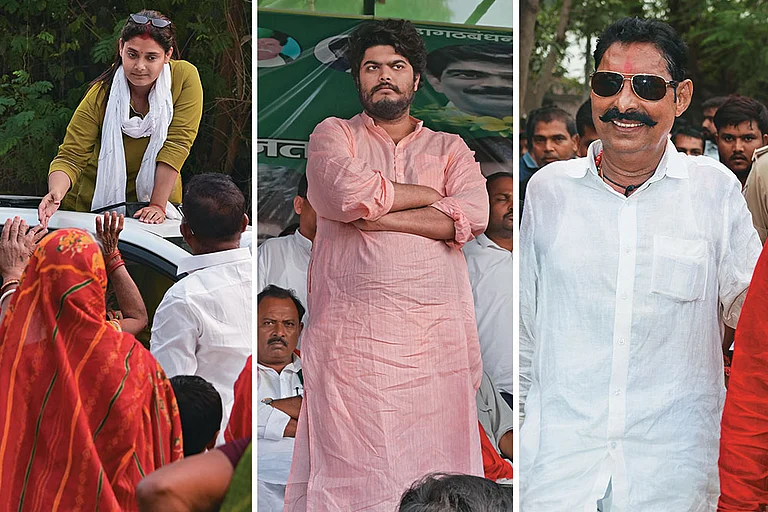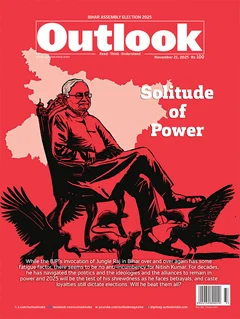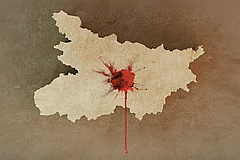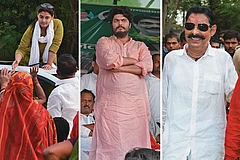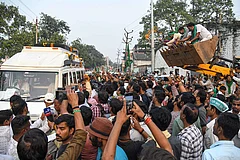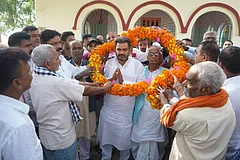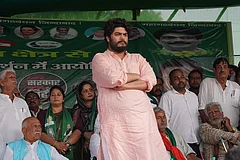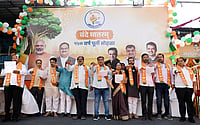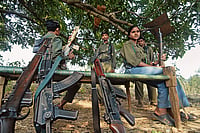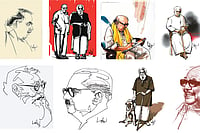
Former Uttar Pradesh chief minister Akhilesh Yadav campaigned in Siwan’s Raghunathpur for Osama Shahab, son of the late gangster-politician Mohammad Shahabuddin, underscoring the symbolic and emotional pull of the Shahabuddin legacy in Bihar politics.
The rally also marked a striking moment of reconciliation, with CPI(ML) (Liberation) leader Amarjeet Kushwaha sharing the stage with Shahabuddin’s son.
Siwan’s political landscape has evolved dramatically, with shifting alliances among RJD, JD(U), and CPI(ML)(Liberation); the left party remains influential enough to secure seats within the INDIA bloc’s seat-sharing arrangements.
On November 3, three days before the first phase of polling in Bihar, former Uttar Pradesh chief minister and Samajwadi Party supremo Akhilesh Yadav came to Raghunathpur assembly constituency in Siwan district to campaign for the INDIA bloc candidate, Osama Shahab. To get a former chief minister from another state to campaign for a poll debutant takes something special. In this case, it was Shahab’s identity—his late father was the gangster-turned-politician Mohammad Shahabuddin. The son is contesting on a Rashtriya Janata Dal (RJD) ticket, the party his father represented.
Standing next to Shahabuddin’s son on the dais and holding his hand in a show of unity was Amarjeet Kushwaha, a leader of the Communist Party of India (Marxist-Leninist) (Liberation) who represents the neighbouring Jiradei constituency in the assembly and is defending his seat in the election.
The CPI(ML) (Liberation) has always held Shahabuddin to be the “real culprit” behind the 1997 murder of Chandrasekhar, better known as Comrade Chandu, a former student leader from Delhi’s Jawaharlal Nehru University who became a CPI(ML) organiser in the gangster’s stronghold. For over a decade from the early 1990s to around 2005, the CPI(ML)(Liberation) had a series of conflicts, often bloody, with the gangs of Shahabuddin, whose writ then ran across and beyond Siwan. Chandrasekhar’s photos still adorn the walls of every Liberation office, but the days of the party’s bitter and bloody rivalries with Shahabuddin’s men seem to have long gone.
Meanwhile, the RJD’s Tejashwi Yadav, the chief ministerial face of the opposition alliance in Bihar, did not make it to Jiradei for a rally scheduled on November 1 as his helicopter could not take off due to bad weather. In a video message addressing the voters of Jiradei, Tejashwi apologised for his absence and urged them to ensure Kushwaha’s victory. Indeed, Siwan’s political alignments have changed unrecognisably in three decades.
During the 1990s, when Tejashwi’s father, Lalu Prasad, helmed Bihar, criminalisation of politics, especially in Siwan, had become a matter of national debate. While the landed class in the Shahabad (Bhojpur) and Magadh region were backing the Ranvir Sena, the notorious private army, against the movement for land redistribution to poor and landless peasants organised by Naxalite parties, including the CPI(ML) (Liberation), in Siwan, Shahabuddin had openly provided “a political umbrella to those upper castes (landlords)” who wanted to fight the Naxalites.
The old wounds seem to have healed, while the CPI(ML)(Liberation’s) alliance with the RJD and the Congress has only become stronger since 2020. In 2016, coming out of jail after 11 years, Shahabuddin had lamented that those whom he used to protect had all shifted allegiance to the BJP. And there lies the key to the smoothening of the Liberation-RJD relations—the landed gentry are standing strong with the saffron party. “The reality has changed significantly with the rise of the BJP, a feudal, communal and undemocratic force,” Kushwaha argues. “As alliance partners, we are all working towards the same goal of ensuring a clean sweep of Siwan district and toppling the National Democratic Alliance (NDA) government.”
Satyadeo Ram, a four-time CPI(ML) (Liberation) MLA and the contender from Darauli, echoes Kushwaha. “Many things have changed since the BJP came to power in India in 2014,” he says. Ram handled many conflicts with Shahabuddin’s men during the 1990s and fought them out to win in 1990, in 2000 and in the February 2005 election from Mairwa, before losing the October 2005 election by a narrow margin of 380 votes. That election gave Bihar a new chief minister, Nitish Kumar of the Janata Dal (United), whose rule has continued ever since.
Ram does not seem to bear any grudge against the RJD or Shahabuddin. Removing the BJP-JD(U) government from power tops the party’s immediate agenda, he says, and highlights the rising crime graph in recent years and the BJP’s “anti-people policies”.
“We fought Shahabuddin tooth and nail when the feudal forces used him as their henchmen. Now, the feudal forces use the BJP. In fact, they are the BJP. Our chief opponent was the feudal forces then and now as well,” says Ram, one of the founders of the CPI(ML) in Siwan in the late 1980s.
Amid this electoral enthusiasm and pragmatism, what has happened to the CPI(ML)’s core issue—land redistribution?
Jiradei was Shahabuddin’s original fortress, where he stunned local politicians in 1990 as a 23-year-old debutant winning the seat as an Independent candidate. He soon joined the Janata Dal, got re-elected from Jiradei in 1995 on the party’s ticket, and then made it to Parliament in 1996 by winning the Siwan Lok Sabha seat. After Lalu Prasad formed the RJD in 1997, Shahabuddin chose to side with him and became the ‘boss’ of Siwan.
Alongside his rise was that of the CPI(ML)(Liberation) in Siwan, with movements focussed on seizing land in excess of the legal ceiling from the big landlords for distribution among the landless. The CPI(ML)’s base was mostly among the backward castes, who owned little or no land, and their arch rivals were the landed gentry from the dominant castes, mostly Rajputs and Bhumihars. The Yadavs, the key social base of Lalu’s party, were on both sides—some in the landless camp, some among the landed. The CPI(ML)(Liberation) won Jiradei’s neighbouring Darauli and Mairwa constituencies in the 1995 assembly election, and by the 1999 parliamentary election emerged as Shahabuddin’s chief rival in Siwan.
It was a decade when the left parties in Bihar recorded their electoral peak. Of the 243 seats of the Bihar part of the then-undivided Bihar assembly, 34 seats were held among the CPI (24), the CPI(M) (5) and the CPI(ML)(Liberation) (5) in 1995. However, the emergence of caste-based electoral politics following the Mandal Commission report of 1992, on the one hand, and the Ram Temple-oriented Hindutva politics, on the other, ate into the traditional left electoral space of the CPI and the CPI(M).
Through the 1990s, the CPI(ML)(Liberation), besides having elected representatives, also had armed squads to take on the private armies of the landlords, as well as to fight the rival Naxalite parties. By the turn of the new century, the CPI(ML)(Liberation) had overtaken the CPI as the state’s key left force, not so much for its own growth as for the CPI’s steep decline. All left parties suffered a setback during the 2010s—only CPI won one seat in 2010 and only the CPI(ML)(Liberation) won three seats in 2015.
In Siwan, Nitish’s JD(U) emerged as the RJD’s key opponent in the new century and the Liberation’s influence waned, but not so much as to be ignored. That is why the RJD-Congress alliance gave three seats in the district to the CPI(ML)(Liberation) in the 2020 election—Darauli, Jiradei and Daraunda. The party won the first two. Now, winning all three is the target.
The left parties’ alliance with the RJD and the Congress in 2020 turned out to be mutually beneficial, especially for the RJD and the CPI(ML) in the Bhojpur and Magadh regions. The CPI(ML) won 12 seats, while the CPI and the CPI(M) won two each. The Liberation vote share helped the RJD sail through in several seats.
During the 1970s, ’80s and the ’90s, several thousand marginalised people gained their socio-economic rights by fighting oppression based on caste and land ownership due to the movements led by the CPI(ML)(Liberation), first as an underground force and then overground, especially in the Bhojpur and Magadh regions. Once rooted among the landless peasantry, the party has, over time, also focussed on building a base among the middle class, including small traders, workers in the unorganised sector and the urban poor.
Political observers mostly see its role in alliance building after the Narendra Modi government’s return to power in 2019 as a key catalyst behind the party’s growth since 2020—winning 12 assembly seats in 2020 and two Lok Sabha seats in 2024. Identifying the BJP as the biggest danger, the CPI(ML) looked to forge the broadest possible alliance against the BJP and its allies, and its leaders are even believed to have played mediators between the Congress and the RJD when the alliance faced internal conflicts.
In this election, the party is raising general issues regarding the Nitish government’s “misrule”, including lack of employment generation leading to widespread job-related migration, unstable law and order, divisive politics and poor services. The alleged connivance between the BJP and the Election Commission of India has emerged as one of the focus issues.
Amid this electoral enthusiasm and pragmatism, what has happened to the CPI(ML)’s core issue—land redistribution? Divya Gautam, a 34-year-old academic and social activist who contested the election on a CPI(ML)(Liberation) ticket from Digha constituency in Patna district, doesn’t think the party has abandoned the issue. “Land redistribution is part of our manifesto,” she says. “It remains very much central to the party’s agenda. We have only broadened our approach, appealing to a wider section of the masses who have suffered from the NDA’s misrule.”
Gautam affirms there is no discomfort with the RJD or the Congress at the grassroots level, and highlights how Lalu, the RJD founder-helmsman, invited her to the alliance’s joint programmes. Party general secretary Dipankar Bhattacharya says alliance partners opposed inclusion of land redistribution in accordance with the Bandyopadhyay Commission’s recommendations in their common agenda, arguing the commission’s report is nearly two decades old and that there should be a fresh survey on landholding. That, nevertheless, leaves the question of land redistribution—a central agenda of the party—as unresolved as it has been over the past two decades.
MORE FROM THIS ISSUE
This story appeared in print as How The BJP’s Rise Changed Bihar’s Left in Outlook’s November 10 issue Solitude Of Power, in which we trace Bihar’s enduring political grammar, where caste equations remain constant, alliances shift like sand, and one man’s survival instinct continues to shape the state’s destiny.
Snigdhendu Bhattacharya is a journalist, author and researcher







